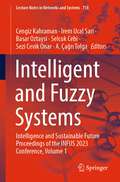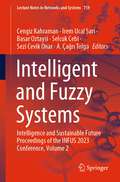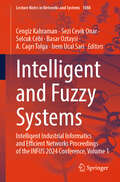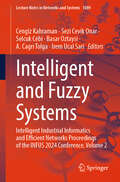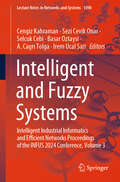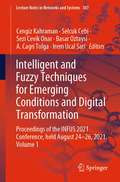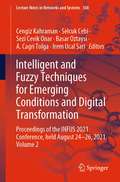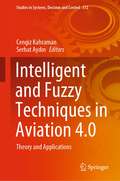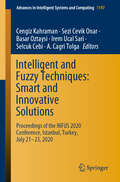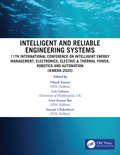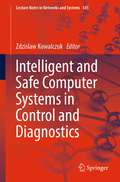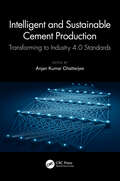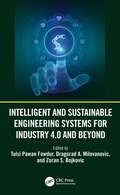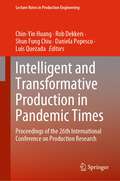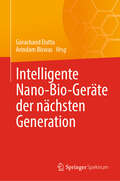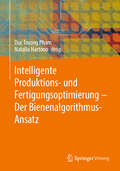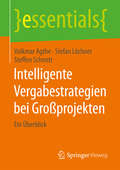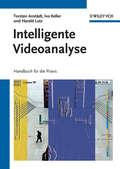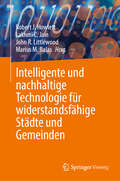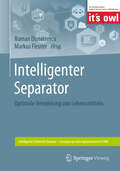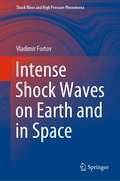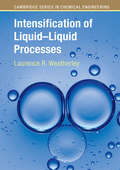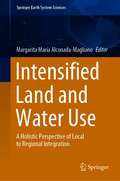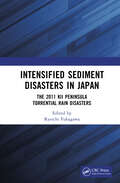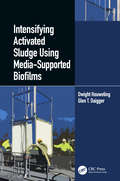- Table View
- List View
Intelligent and Fuzzy Systems: Intelligence and Sustainable Future Proceedings of the INFUS 2023 Conference, Volume 1 (Lecture Notes in Networks and Systems #758)
by Cengiz Kahraman Selcuk Cebi Sezi Cevik Onar Basar Oztaysi Irem Ucal Sari A. Çağrı TolgaThis book consists of the papers accepted after a careful review process at an international scientific meeting where the latest developments on intelligent and fuzzy systems are presented and discussed. The latest developments in both the theoretical and practical fields of the new fuzzy set extensions have been prepared by expert researchers. Contributed by participants from more than 40 different countries, this book is also a useful resource in terms of showing the levels that fuzzy and intelligent systems have reached in various countries of the world. The intended readers are intelligent and fuzzy systems researchers, lecturers, M.Sc., and Ph.D. students studying fuzzy sets and artificial intelligence. The book covers fuzzy logic theory and applications, heuristics, and metaheuristics from optimization to machine learning, from quality management to risk management, making the book an excellent source for researchers.
Intelligent and Fuzzy Systems: Intelligence and Sustainable Future Proceedings of the INFUS 2023 Conference, Volume 2 (Lecture Notes in Networks and Systems #759)
by Cengiz Kahraman Selcuk Cebi Sezi Cevik Onar Basar Oztaysi Irem Ucal Sari A. Çağrı TolgaThis book consists of the papers accepted after a careful review process at an international scientific meeting where the latest developments on intelligent and fuzzy systems are presented and discussed. The latest developments in both the theoretical and practical fields of the new fuzzy set extensions have been prepared by expert researchers. Contributed by participants from more than 40 different countries, this book is also a useful resource in terms of showing the levels that fuzzy and intelligent systems have reached in various countries of the world. The intended readers are intelligent and fuzzy systems researchers, lecturers, M.Sc., and Ph.D. students studying fuzzy sets and artificial intelligence. The book covers fuzzy logic theory and applications, heuristics, and metaheuristics from optimization to machine learning, from quality management to risk management, making the book an excellent source for researchers.
Intelligent and Fuzzy Systems: Intelligent Industrial Informatics and Efficient Networks Proceedings of the INFUS 2024 Conference, Volume 1 (Lecture Notes in Networks and Systems #1088)
by Cengiz Kahraman Selcuk Cebi Sezi Cevik Onar Basar Oztaysi Irem Ucal Sari A. Cagrı TolgaThis book presents recent research in intelligent and fuzzy techniques on Intelligent Industrial Informatics and Efficient Networks. This cutting-edge field integrates advanced technologies, such as artificial intelligence, machine learning and data analytics, into industrial processes, revolutionizing the way industries operate. The book presents the examples of the implementation of smart sensors and IoT devices, which facilitate real-time data collection and communication. High-speed, low-latency networks ensure that information flows effortlessly between devices, enabling timely responses and enabling the coordination of complex manufacturing processes. This network architecture supports the integration of edge computing, where data processing occurs closer to the source, reducing latency and enabling faster decision-making. The readers can benefit from this book for maintaining a leadership position among competitors in both manufacturing and service companies. The intended readers are intelligent and fuzzy systems researchers, lecturers, M.Sc. and Ph.D. students studying intelligent and fuzzy techniques. The book covers fuzzy logic theory and applications, heuristics and metaheuristics from optimization to machine learning, from quality management to risk management, making the book an excellent source for researchers.
Intelligent and Fuzzy Systems: Intelligent Industrial Informatics and Efficient Networks Proceedings of the INFUS 2024 Conference, Volume 2 (Lecture Notes in Networks and Systems #1089)
by Cengiz Kahraman Selcuk Cebi Sezi Cevik Onar Basar Oztaysi Irem Ucal Sari A. Cagrı TolgaThis book presents recent research in intelligent and fuzzy techniques on Intelligent Industrial Informatics and Efficient Networks. This cutting-edge field integrates advanced technologies, such as artificial intelligence, machine learning and data analytics, into industrial processes, revolutionizing the way industries operate. The book presents the examples of the implementation of smart sensors and IoT devices, which facilitate real-time data collection and communication. High-speed, low-latency networks ensure that information flows effortlessly between devices, enabling timely responses and enabling the coordination of complex manufacturing processes. This network architecture supports the integration of edge computing, where data processing occurs closer to the source, reducing latency and enabling faster decision-making. The readers can benefit from this book for maintaining a leadership position among competitors in both manufacturing and service companies. The intended readers are intelligent and fuzzy systems researchers, lecturers, M.Sc. and Ph.D. students studying intelligent and fuzzy techniques. The book covers fuzzy logic theory and applications, heuristics and metaheuristics from optimization to machine learning, from quality management to risk management, making the book an excellent source for researchers.
Intelligent and Fuzzy Systems: Intelligent Industrial Informatics and Efficient Networks Proceedings of the INFUS 2024 Conference, Volume 3 (Lecture Notes in Networks and Systems #1090)
by Cengiz Kahraman Selcuk Cebi Sezi Cevik Onar Basar Oztaysi Irem Ucal Sari A. Cagrı TolgaThis book presents recent research in intelligent and fuzzy techniques on Intelligent Industrial Informatics and Efficient Networks. This cutting-edge field integrates advanced technologies, such as artificial intelligence, machine learning and data analytics, into industrial processes, revolutionizing the way industries operate. The book presents the examples of the implementation of smart sensors and IoT devices, which facilitate real-time data collection and communication. High-speed, low-latency networks ensure that information flows effortlessly between devices, enabling timely responses and enabling the coordination of complex manufacturing processes. This network architecture supports the integration of edge computing, where data processing occurs closer to the source, reducing latency and enabling faster decision-making. The readers can benefit from this book for maintaining a leadership position among competitors in both manufacturing and service companies. The intended readers are intelligent and fuzzy systems researchers, lecturers, M.Sc. and Ph.D. students studying intelligent and fuzzy techniques. The book covers fuzzy logic theory and applications, heuristics and metaheuristics from optimization to machine learning, from quality management to risk management, making the book an excellent source for researchers.
Intelligent and Fuzzy Techniques for Emerging Conditions and Digital Transformation: Proceedings of the INFUS 2021 Conference, held August 24-26, 2021. Volume 1 (Lecture Notes in Networks and Systems #307)
by Cengiz Kahraman Selcuk Cebi Sezi Cevik Onar Basar Oztaysi A. Cagri Tolga Irem Ucal SariThis book presents recent research in intelligent and fuzzy techniques. Emerging conditions such as pandemic, wars, natural disasters and various high technologies force people for significant changes in business and social life. The adoption of digital technologies to transform services or businesses, through replacing non-digital or manual processes with digital processes or replacing older digital technology with newer digital technologies through intelligent systems is the main scope of this book. It focuses on revealing the reflection of digital transformation in our business and social life under emerging conditions through intelligent and fuzzy systems. The latest intelligent and fuzzy methods and techniques on digital transformation are introduced by theory and applications. The intended readers are intelligent and fuzzy systems researchers, lecturers, M.Sc. and Ph.D. students studying digital transformation. Usage of ordinary fuzzy sets and their extensions, heuristics and metaheuristics from optimization to machine learning, from quality management to risk management makes the book an excellent source for researchers.
Intelligent and Fuzzy Techniques for Emerging Conditions and Digital Transformation: Proceedings of the INFUS 2021 Conference, held August 24-26, 2021. Volume 2 (Lecture Notes in Networks and Systems #308)
by Cengiz Kahraman Selcuk Cebi Sezi Cevik Onar Basar Oztaysi A. Cagri Tolga Irem Ucal SariThis book presents recent research in intelligent and fuzzy techniques. Emerging conditions such as pandemic, wars, natural disasters and various high technologies force people for significant changes in business and social life. The adoption of digital technologies to transform services or businesses, through replacing non-digital or manual processes with digital processes or replacing older digital technology with newer digital technologies through intelligent systems is the main scope of this book. It focuses on revealing the reflection of digital transformation in our business and social life under emerging conditions through intelligent and fuzzy systems. The latest intelligent and fuzzy methods and techniques on digital transformation are introduced by theory and applications. The intended readers are intelligent and fuzzy systems researchers, lecturers, M.Sc. and Ph.D. students studying digital transformation. Usage of ordinary fuzzy sets and their extensions, heuristics and metaheuristics from optimization to machine learning, from quality management to risk management makes the book an excellent source for researchers.
Intelligent and Fuzzy Techniques in Aviation 4.0: Theory and Applications (Studies in Systems, Decision and Control #372)
by Cengiz Kahraman Serhat AydınThis book offers a comprehensive reference guide for the theory and practice of intelligent and fuzzy techniques in Aviation 4.0. It provides readers with the necessary intelligent and fuzzy tools for Aviation 4.0 when incomplete, vague, and imprecise information or insufficient data exist in hand, where classical modeling approaches cannot be applied. The respective chapters, written by prominent researchers, explain a wealth of both basic and advanced concepts including baggage services, catering services, check-in and boarding services, maintenance and cargo management, security, etc. To foster reader comprehension, all chapters include relevant numerical examples or case studies. Taken together, they form an excellent reference guide for researchers, lecturers, and postgraduate students pursuing research on Aviation 4.0. Moreover, by extending all the main aspects of Aviation 4.0 to its intelligent and fuzzy counterparts, the book presents a dynamic snapshot of the field that is expected to stimulate new directions, ideas, and developments.
Intelligent and Fuzzy Techniques: Proceedings of the INFUS 2020 Conference, Istanbul, Turkey, July 21-23, 2020 (Advances in Intelligent Systems and Computing #1197)
by Cengiz Kahraman Selcuk Cebi Sezi Cevik Onar Basar Oztaysi A. Cagri Tolga Irem Ucal SariThis book gathers the most recent developments in fuzzy & intelligence systems and real complex systems presented at INFUS 2020, held in Istanbul on July 21–23, 2020. The INFUS conferences are a well-established international research forum to advance the foundations and applications of intelligent and fuzzy systems, computational intelligence, and soft computing, highlighting studies on fuzzy & intelligence systems and real complex systems at universities and international research institutions. Covering a range of topics, including the theory and applications of fuzzy set extensions such as intuitionistic fuzzy sets, hesitant fuzzy sets, spherical fuzzy sets, and fuzzy decision-making; machine learning; risk assessment; heuristics; and clustering, the book is a valuable resource for academics, M.Sc. and Ph.D. students, as well as managers and engineers in industry and the service sectors.
Intelligent and Reliable Engineering Systems: 11th International Conference on Intelligent Energy Management, Electronics, Electric & Thermal Power, Robotics and Automation (IEMERA-2020)
by Nikesh Kumar; Len Gelman; Arun Kumar Bar; Satyajit ChakrabartiIEMERA is a three-day International Conference specially designed with cluster of scientific and technological sessions, providing a common platform for the researchers, academicians, industry delegates across the globe to share and exchange their knowledge and contribution. The emerging areas of research and development in Electrical, Electronics, Mechanical and Software technologies are major focus areas. The conference is equipped with well-organized scientific sessions, keynote and plenary lectures, research paper and poster presentations and world-class exhibitions. Moreover, IEMERA 2020 facilitates better understanding of the technological developments and scientific advancements across the world by showcasing the pace of science, technology and business areas in the field of Energy Management, Electronics, Electric & Thermal Power, Robotics and Automation.
Intelligent and Safe Computer Systems in Control and Diagnostics (Lecture Notes in Networks and Systems #545)
by Zdzislaw KowalczukThe main subject matter of the book is related to the demands of research and industrial centers for diagnostics, monitoring, and decision-making systems that result from the increasing complexity of automation and systems, the need to ensure the highest level of reliability and safety, and continuing research and the development of innovative approaches to fault diagnosis. Most welcome are combinations of domains of engineering knowledge for diagnosis, including detection, isolation, localization, identification, reconfiguration, and fault-tolerant control. This field is open to new challenges, including industrial diagnostics, diagnostics of computer systems and networks, as well as non-industrial applications in the form of medical diagnostics, especially those based on artificial intelligence and deep neural networks.Our community is mainly interested in the following six topics: fault detection, isolation, and identification (FDI); (ii) fault-tolerant control systems; (iii) process safety, quality, and reliability; (iv) medical diagnostics; as well as (v) methodologies based on mathematical modeling, parameter identification and state estimation, qualitative models, statistical and signal processing, artificial intelligence, fuzzy logic and rough sets, expert systems, neural networks; and (vi) industrial applications of diagnostics in fault-tolerant problems, safety, monitoring and alarming, quality control, computer systems and networks, diagnostic software, software reliability, medicine and therapy, environment protection, production control, and other industries such as chemistry, electronics, and power systems. The book is divided into six parts: (I) Artificial Intelligence in Medicine; (II) Cybersecurity; (III) Artificial Neural Networks; (IV) Fault Detection; (V) Systems Modeling; and (VI) Adaptive, Robust and FTC Systems.
Intelligent and Sustainable Cement Production: Transforming to Industry 4.0 Standards
by Anjan Kumar ChatterjeeThis book captures the path of digital transformation that the cement enterprises are adopting progressively to elevate themselves to ‘Industry 4.0’ level. Digital innovations-based Internet of Things (IoT) and Artificial Intelligence (AI) are pertinent technologies for the cement enterprises as the manufacturing processes operate at very large scales with multiple inputs, outputs, and variables, resulting in the essentiality of big data management. Featuring contributions from cement industries worldwide, it covers various aspects of cement manufacturing from IoT, machine learning and data analytics perspective. It further discusses implementation of digital solutions in cement process and plants through case studies. Features: Present an up-to-date, consolidated view on modern cement manufacturing technology, applying new systems. Provides narration of complexity and variables in modern cement plants and processes. Discusses evolution of automation and computerization for the manufacturing processes. Covers application of ERP techniques to cement enterprises. Includes data-driven approaches for energy, environment, and quality management. This book aims at researchers and industry professionals involved in cement manufacturing, cement machinery and system suppliers, chemical engineering, process engineering, industrial engineering, and chemistry.
Intelligent and Sustainable Engineering Systems for Industry 4.0 and Beyond
by Zoran S. Bojkovic Dragorad A. Milovanovic Tulsi Pawan FowdurThe Fourth Industrial Revolution, Industry 4.0, aims to significantly improve the flexibility, versatility, usability and efficiency of future smart factories. However, the concept of Industry 4.0 is not only limited to the factory but also encompasses the entire life cycle of the product, that is, from production and suppliers, to end users. Industry 4.0 delivers seamless vertical and horizontal integration down the entire value chain and across all layers of the automation pyramid.Industry 4.0 has its roots in a project for the high‑tech strategy of the German Government back in 2011, which led to the progression of cyber-physical systems into cyber-physical production systems (CPPS). CPPS can make intelligent decisions through real‑time communication and cooperation between manufacturing entities. Smart Factory, which is based on CPPS and artificial intelligence (AI), is one of the key associated initiatives of Industry 4.0. This enables flexible production of high‑quality personalized products with mass efficiency. Another important aspect of Industry 4.0 is sustainable engineering systems that can help make its processes align with the United Nations Sustainable Development Goals (UN SDGs). Sustainable and intelligent engineering systems such as 5G, Industrial IoT, robotics and automation, renewable energy, logistics and even intelligent waste management can be the main enablers of Industry 4.0.This is a multidisciplinary book and is meant for anyone with a basic engineering background interested in acquiring a solid foundation in the fundamental concepts and state‑of‑the‑art research trends in Industry 4.0. It explores the application of AI and machine learning as well as sustainable engineering systems, which can be the main drivers for Industry 4.0 and beyond and have a significant impact on the UN SDGs.
Intelligent and Transformative Production in Pandemic Times: Proceedings of the 26th International Conference on Production Research (Lecture Notes in Production Engineering)
by Rob Dekkers Chin-Yin Huang Shun Fung Chiu Daniela Popescu Luis QuezadaThis book contains the proceeding of the 26th International Conference on Production Research (ICPR). ICPR is a biennial conference that has been hosted for more than a half century. It is regarded worldwide as one of the leading conferences of production research, industrial engineering, and related subjects. The acute impact of the pandemic on human lives is spurring further research and advances: because modern life relies on production and supply networks. The future of production calls for transformative research exploiting the possibilities of artificial intelligence in particular to respond to the challenge of sustainability. This book is of interest to researchers, students, and professionals in industry.
Intelligente Nano-Bio-Geräte der nächsten Generation
by Arindam Biswas Gorachand DuttaDieses Buch befasst sich mit den Herausforderungen bei der Entwicklung einer Point-of-Care-Testplattform. Das Buch beschreibt Assays auf Basis gedruckter Chips (Lab-on-a-Chip, Lab-on-a-PCB) für den schnellen, kostengünstigen Nachweis von Biomarkern in realen Proben. Die größten Herausforderungen bei Point-of-Care-Tests sind die Implementierung komplexer Analysemethoden in kostengünstige Technologien. Dies gilt insbesondere für Länder mit einer weniger entwickelten Gesundheitsinfrastruktur. Waschfreie, Lab-on-Chip- und Lab-on-PCB-Techniken sind sehr einfach und innovativ für die Entwicklung von Point-of-Care-Geräten. Mit der Redox-Cycling-Technologie können mehrere interessante Targets gleichzeitig auf einem gedruckten Chip nachgewiesen werden. Die vorgeschlagenen Bereiche sind von Natur aus disziplinübergreifend und vereinen Fachwissen aus den Bereichen Biosensorik, Elektrochemie, Elektronik und Elektrotechnik, Gesundheitswesen und Fertigung. Dieses Buch befasst sich mit den jüngsten Fortschritten und verschiedenen Forschungsfragen im Bereich der Nanobiotechnologie-gestützten Biosensorik und sucht nach theoretischen, methodischen, etablierten und validierten empirischen Arbeiten, die sich mit diesen verschiedenen Themen befassen.
Intelligente Produktions- und Fertigungsoptimierung - Der Bienenalgorithmus-Ansatz
by Duc Truong Pham Natalia HartonoDieses Buch ist das erste Werk, das sich mit dem Bienenalgorithmus beschäftigt. Nach einer sanften Einführung in die wichtigsten Ideen, die dem Algorithmus zugrunde liegen, stellt das Buch aktuelle Ergebnisse und Entwicklungen im Zusammenhang mit dem Algorithmus und seiner Anwendung auf Optimierungsprobleme in Produktion und Fertigung vor.Mit dem Beginn der vierten industriellen Revolution sind Produktions- und Fertigungsprozesse und -systeme immer komplexer geworden. Um die beste Leistung aus ihnen herauszuholen, sind effiziente und effektive Optimierungstechniken erforderlich, die nicht von der Verfügbarkeit von Prozess- oder Systemmodellen abhängen. Solche Modelle sind in der Regel entweder nicht verfügbar oder aufgrund des hohen Grades an Nichtlinearität und Unsicherheiten in den darzustellenden Prozessen und Systemen mathematisch schwer zu lösen. Der Bienenalgorithmus ist eine leistungsstarke, schwarmbasierte, intelligente Optimierungs-Metaheuristik, die vom Suchverhalten der Honigbienen inspiriert ist. Der Algorithmus ist konzeptionell elegant und extrem einfach anzuwenden. Alles, was er zur Lösung eines Optimierungsproblems benötigt, ist ein Mittel zur Bewertung der Qualität potenzieller Lösungen. Dieses Buch zeigt die Einfachheit, Effektivität und Vielseitigkeit des Algorithmus und ermutigt Ingenieure und Forscher auf der ganzen Welt, ihn weiter einzusetzen, um eine intelligente und nachhaltige Fertigung und Produktion im Zeitalter von Industrie 4.0 und darüber hinaus zu realisieren.
Intelligente Vergabestrategien bei Großprojekten: Ein Überblick (essentials)
by Volkmar Agthe Stefan Löchner Steffen SchmittDie Autoren untersuchen die Voraussetzungen f#65533;r eine erfolgreiche Vergabestrategie bei Gro#65533;projekten. Zun#65533;chst analysieren sie die Risiken f#65533;r die am Bau Beteiligten und stellen Varianten dar, wie Planungs- und Bauleistungen zu vergeben sind. Danach werden die M#65533;glichkeiten und Grenzen von in j#65533;ngerer Zeit ,,in Mode gekommenen" Vergabemodellen, insbesondere die Vergabe mit Garantiertem Maximalpreis bzw. die Beauftragung von Construction Managern, diskutiert. Hierauf und auf einer Analyse der typischen Struktur eines (gro#65533;en) Bauprojekts aufbauend, wird ein Vergabemodell entwickelt, das einerseits den Risiken der Baubeteiligten Rechnung tr#65533;gt, andererseits dem Bauherrn die erforderliche Flexibilit#65533;t bel#65533;sst. So kann er in einem kompetitiven Umfeld ein seinen Vorstellungen bez#65533;glich Kosten, Qualit#65533;ten und Terminen entsprechendes Bauvorhaben realisieren.
Intelligente Videoanalyse: Handbuch f¿r die Praxis
by Ivo Keller Harald Lutz Torsten Anst¿dtIntelligente Videoanalyse bezeichnet Systeme aus Kameras und Software, die selbsttätig bestimmte Objekte identifizieren und deren Bewegungen verfolgen können. Obwohl sie in immer mehr Feldern wie Gebäudesicherung und Verkaufsförderung eingesetzt wird, fehlte bislang ein Buch, welches den gegenwärtigen Stand der Technik, der Probleme und der Anwendungsgebiete in übersichtlicher Form beschreibt. Das einzige Buch zu diesem vielseitig relevanten Thema deckt von Planung über Algorithmen bis Datenschutz alle relevanten Aspekte ab.
Intelligente und nachhaltige Technologie für widerstandsfähige Städte und Gemeinden
by Lakhmi C. Jain Robert J. Howlett John R. Littlewood Marius M. BalasBei diesem Buch handelt es sich um eine Sammlung erweiterter Fassungen von Vorträgen, die auf dem internationalen KES-Gipfel Covid-19 Herausforderung gehalten wurden. Der Schwerpunkt des Buches liegt auf technologischen, wirtschaftlichen und sozialen Entwicklungen zur Bekämpfung der Auswirkungen globaler und lokaler Katastrophen sowie auf der Frage, wie die Erholung von Covid genutzt werden kann, um widerstandsfähigere und nachhaltigere Gemeinschaften und Industrien aufzubauen und die Umwelt zu verbessern. Auch die globalen Herausforderungen des vom Menschen beeinflussten Klimawandels werden erörtert. Die Kapitel befassen sich mit der Stärkung der Widerstandsfähigkeit von Städten und Gemeinden durch Energieautarkie, Lebensmittelproduktion, widerstandsfähige Wohnungen und Gebäude, menschliche Gesundheit und intelligente Systeme, z. B. für Vorhersagen und Prognosen.
Intelligenter Separator: Optimale Veredelung von Lebensmitteln (Intelligente Technische Systeme – Lösungen aus dem Spitzencluster it’s OWL)
by Roman Dumitrescu Markus FleuterDas Buch beinhaltet die Ergebnisse des dreijährigen Verbundprojekts "Separator i4.0" des BMBF-Spitzenclusters it's OWL. Gegenstand des Projekts war die nachhaltige Einbindung von Expertenwissen in die zukunftsweisende Weiterentwicklung und Optimierung von Separationsprozessen. Durch die Entwicklung neuartiger intelligenter Komponenten aus dem Bereich der Sensorik wird es zukünftig möglich sein, Separatoren und die zugehörigen Prozesszusammenhänge zu verstehen und diese ökologisch/ökonomisch optimal auszulegen und zu betreiben. Hierzu wurde ein Instrumentarium bestehend aus Methoden und Lösungen erarbeitet, das darüber hinaus auf analoge Problemstellungen komplexer maschinenbaulicher Anlagen anwendbar sein wird.
Intense Shock Waves on Earth and in Space (Shock Wave and High Pressure Phenomena)
by Vladimir FortovThis book focuses on the non-traditional branches of physics and mechanics of shock waves that have arisen recently in connection with the intensive study of these waves in a wide variety of phenomena - from nuclear matter to clusters of galaxies. The book is devoted to the various physical phenomena and properties of intense shock waves.The author addresses methods of generation, diagnostics, as well as theoretical methods for describing shock waves at extremely high pressures and temperatures in laboratory and quasi-laboratory conditions. The state of materials with high energy density generated by shock wave compression is discussed. In addition, the book aims to systematize, generalize, and describe from a universal viewpoint the extensive theoretical and experimental material on the physics of high energy densities - the physics and mechanics of intense shock waves. The book is based on lectures delivered by the author at the Moscow Institute of Physics and Technology, the Higher School of Physics of Rosatom State Nuclear Energy Corporation, as well as overviews presented at many scientific conferences and symposia. It is useful to a wide range of researchers in natural sciences, giving them access to original works and allowing them to navigate the fascinating problems of the modern science of intense shock waves.
Intensification of Liquid–Liquid Processes (Cambridge Series in Chemical Engineering)
by Laurence R. WeatherleyExplore and review novel techniques for intensifying transport and reaction in liquid-liquid and related systems with this essential toolkit. Topics include discussion of the principles of process intensification, the nexus between process intensification and sustainable engineering, and the fundamentals of liquid-liquid contacting, from an expert with over forty-five years' experience in the field. Providing promising directions for investment and for new research in process intensification, in addition to a unique review of the fundamentals of the topic, this book is the perfect guide for senior undergraduate students, graduate students, developers, and research staff in chemical engineering and biochemical engineering.
Intensified Land and Water Use: A Holistic Perspective of Local to Regional Integration (Springer Earth System Sciences)
by Margarita María Alconada-MaglianoThis book combines multidisciplinary studies on the environmental consequences of intensified use of land and water, and the fusion of land to provide food for a growing population. Studies on water, vegetation, and soil are addressed from an environmental management perspective with a special focus on the relation between natural elements and humans. This book considers the essential dynamics of humans and the natural environment, which is especially important in areas with shallow water-table that influence directly on agricultural activities (crops, livestock, and forests), land management, flooding, droughts, waterlogging, salt-affected soils (saline and sodic) and variation in obtained water quality in wells where these processes as related to the local and regional geomorphology control. The studies present hydrological processes towards the definition of an adequate use of soil and water with consequences of its management on the environment. Also, water study procedures are presented as well as their relation to other elements of the landscape. Methodologies such as the Tóthian flow system concept are recognized by different authors to provide the reader with solid interdisciplinary analyses of related environmental components such as soils, vegetation, surface water, geomorphology, geological framework and groundwater physical-chemical composition.
Intensified Landslide Disasters in Japan: The 2011 Kii Peninsula Torrential Rain Disasters
by Ryoichi FukagawaThe 2011 Kii Peninsula disaster was postwar Japan’s largest sediment and flood disaster. This book analyzes the disaster and the emergency response and subsequent disaster-prevention efforts. It also provides an international comparison and recommendations for mitigation and recovery efforts. Although the scale and intensity of the disaster were expected to occur just once every 100 years, global warming has seen the intensification of such disasters around the globe. This book therefore presents an invaluable in-depth reference for readers on how to prepare for such a disaster, identify risk factors, and react accordingly. Contributors draw on the results of field surveys conducted by the Japanese Geotechnical Society at the time of the disaster and subsequent developments. First, they explain the factors that contributed to the disaster, including the meteorological, topographical, and geological conditions at the time of the disaster. They then describe the mechanisms of slope failure and damage caused by the slope failures across Nara, Wakayama, and Mie prefectures. Finally, they describe the post-disaster response, including the recovery and reconstruction and disaster-prevention and mitigation efforts in the affected area. Readers will therefore understand the importance of the contributing factors and be able to improve disaster mitigation strategies and response plans that will save lives and prevent damage to local infrastructure and economies. This book is an invaluable resource for researchers, geologists, practicing engineers, and government officials who are involved in disaster prevention and response. Upper undergraduate and graduate students will also benefit from the book’s in-depth approach.
Intensifying Activated Sludge Using Media-Supported Biofilms
by Dwight Houweling Glen T. DaiggerIntensifying Activated Sludge Using Media-Supported Biofilms will be of interest to practicing wastewater treatment process designers, along with those seeking more compact and energy-efficient wastewater treatment options. The advantages of Moving Bed Biological Reactor (MBBR)-based hybrid processes are now well-established in practice, leading to their increased use in the field. Membrane Aerated Biofilm Reactor (MABR)-based hybrid processes are much newer and offer further systematic process and energy advantages. This book examines the evolution of hybrid technologies as well as the potential for continued improvement of biological wastewater treatment techniques. Features: Reviews current approaches for intensifying biological wastewater treatment processes and their mechanistic bases. Examines hybrid suspended growth/biofilm-based wastewater treatment processes, including the newly-developed MABR-based processes, and their unique dynamic performance characteristics. Presents a novel method for characterizing the performance and process intensification advantages of hybrid processes. Provides guidance for simulating the performance of hybrid processes, including oxygen transfer in MABR hybrid processes.
